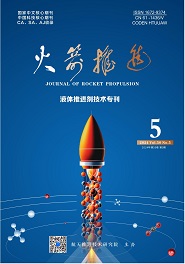航天推进技术研究院主办
CAO Wei,WANG Rui,CHEN Jian,et al.Research on formation mechanism of negative pressure phenomenon in propellant pipeline[J].Journal of Rocket Propulsion,2015,41(04):37-42.
推进剂管路内负压形成机理研究
- Title:
- Research on formation mechanism of negative pressure phenomenon in propellant pipeline
- 分类号:
- V434-34
- 文献标志码:
- A
- 摘要:
- 嫦娥三号着陆器推进系统正样产品在测试过程中,轨控推进剂管路出现了一段时间的负压现象,为查找负压出现的原因,推进系统采用故障树分析方法对推进剂管路内负压形成机理进行了研究,并基于故障树分析结论,进行了单机级、系统级的多项专项验证试验,通过试验研究最终确认了推进剂管路内负压形成机理,该现象是由于嫦娥三号着陆器推进系统检漏时采用纯氦气工质,检漏结束后常压氦气长期存储在推进剂管路内,由于管路内纯氦气浓度远高于外界空气,存在氦气分子通过断流阀微通道缓慢扩散出去现象,随着扩散量的不断下降积累,导致推进剂管路内压力逐步减小,产生了负压。该现象与分子扩散理论的机理和规律相符,为系统正常固有现象,对飞行试验无影响。
- Abstract:
- During testing process of landing propulsion system in Chang'e-3, the negative pressure phenomenon was detected in the propellant pipeline for orbit control. Fault tree analysis method was used to investigate the formation mechanism of the negative pressure phenomenon. Single level and system level validation tests were conducted based on the analytical results from fault tree analysis method. The formation mechanism of the negative pressure phenomenon was confirmed by experiments and investigation. The phenomenon is caused by helium, which is used in the leak hunting of Chang'e-3 propulsion system, and then stayed in the pipeline for a long time. Helium concentration in the pipeline is far higher than the air in environment, so helium molecular diffusion occurs with pressure drop in the system, and the negative pressure phenomenon is appeared. The negative pressure phenomenon coincides
参考文献/References:
[1]王平利, 王志伟. 无定形PET中小分子扩散系数的分子动力学模拟[J]. 化工学报, 2009 (08): 49-54.
[2]孙炜, 陈中, 黄素逸. 模型流体扩散系数与温度关系的分子动力学模拟[J]. 武汉化工学院学报, 2005 (04) 3-6.
[3]霍瑞霞, 刘俊, 杨晓峰, 等. 分子在ITQ-3分子筛窄孔道内扩散的过渡态理论模型[J]. 高等学校化学学报, 2010 (07): 159-163.
[4]刘立凤, 赵亮. 分子在分子筛上扩散行为的分子模拟研究进展[J]. 化工进展, 2011 (07): 21-30.
[5]刘中民, 郑禄彬, 陈国权, 等. 与浓度相关的扩散系数D_t的求取[J]. 中国科学B辑, 1995 (07): 34-39.
[6]王文兰, 黄永. 分子扩散测定方法的研究进展[J]. 化学工程师, 2008 (05): 41-43.
[7]刘娟芳, 曾丹苓. 扩散系数的分子动力学模拟[J]. 工程热物理学报, 2006 (03): 15-17.
[8]宋海华, 尹小勇. 模拟扩散系数的分子动力学方法[J]. 化学物理学报, 2005 (05): 81-85.
[9]秦星, 张秉坚. 微孔隙中流体扩散系数分子动力学模拟的并行算法研究[J]. 计算机与应用化学, 2005 (02): 7- 12.
[10]刘迎春, 王琦, 吕玲红.微孔中简单流体扩散行为的分子动力学模拟研究[J].高等学校化学学报, 2004 (05): 119- 122.
[11]秦星, 张秉坚. 微孔中简单流体混合物扩散系数的分子动力学模拟与关联[J]. 化学物理学报, 2003 (06): 37- 41.
相似文献/References:
[1]章玉华.推进系统并联贮箱均衡排放性能及其控制措施[J].火箭推进,2013,39(03):83.
ZHANG Yu-hua.Equalizing expulsion and control of parallel tanks in propulsion system[J].Journal of Rocket Propulsion,2013,39(04):83.
[2]陈阳春,王爱华,汤建华.某发动机喷管周围流场研究[J].火箭推进,2013,39(05):41.
CHEN Yang-chun,WANG Ai-hua,TANG Jian-hua.Research of flow field around nozzle of an engine[J].Journal of Rocket Propulsion,2013,39(04):41.
[3]袁 磊,王 申,连仁志,等.一种推进剂剩余量在轨测量方法研究[J].火箭推进,2013,39(05):75.
YUAN Lei,WANG Shen,LIAN Ren-zhi,et al.On-board gauging method of remaining propellant[J].Journal of Rocket Propulsion,2013,39(04):75.
[4]刘 川,刘 俊,邱 鑫,等.火星探测器推进系统初步设想[J].火箭推进,2014,40(02):44.
LIU Chuan,LIU Jun,QIU Xin,et al.Preliminary design of propulsion system
for Mars exploration[J].Journal of Rocket Propulsion,2014,40(04):44.
[5]陈朝,黄敏超.空间轨道转移飞行器推进系统静态仿真分析[J].火箭推进,2007,33(06):22.
Chen Zhao,Huang Minchao.Static state simulation study of orbital transfer vehicle propulsion system[J].Journal of Rocket Propulsion,2007,33(04):22.
[6]戴佳,黄敏超,沈赤兵,等.双组元液体挤压推进系统启动过程时序分析[J].火箭推进,2006,32(02):16.
Dai Jia,Huang Minchao,Shen Chibing,et al.Startup process timing analysis of liquid bipropellant pressure-fed propulsion system[J].Journal of Rocket Propulsion,2006,32(04):16.
[7]刘锋,周进.金属膜片贮箱推进剂消耗不平衡分析[J].火箭推进,2006,32(05):28.
Liu Feng,Zhou Jin.Analysis of the unbalanced depletion of the propellant for the metal diaphragm tank[J].Journal of Rocket Propulsion,2006,32(04):28.
[8]丁丰年,张恩昭,张小平,等.论我国重复使用运载器推进系统方案[J].火箭推进,2004,(03):13.
[9]刘昌波.电动泵与挤压式推进系统对比研究[J].火箭推进,2017,43(02):32.
LIU Changbo.Comparative study on electric pump and pressure-fed propulsion systems[J].Journal of Rocket Propulsion,2017,43(04):32.
备注/Memo
收稿日期:2015-02-06;修回日期:2015-03-27 基金项目:中国航天科技集团公司支撑项目(2012JY03) 作者简介:曹伟(1981—),男,高级工程师,研究领域为液体火箭发动机系统设计
